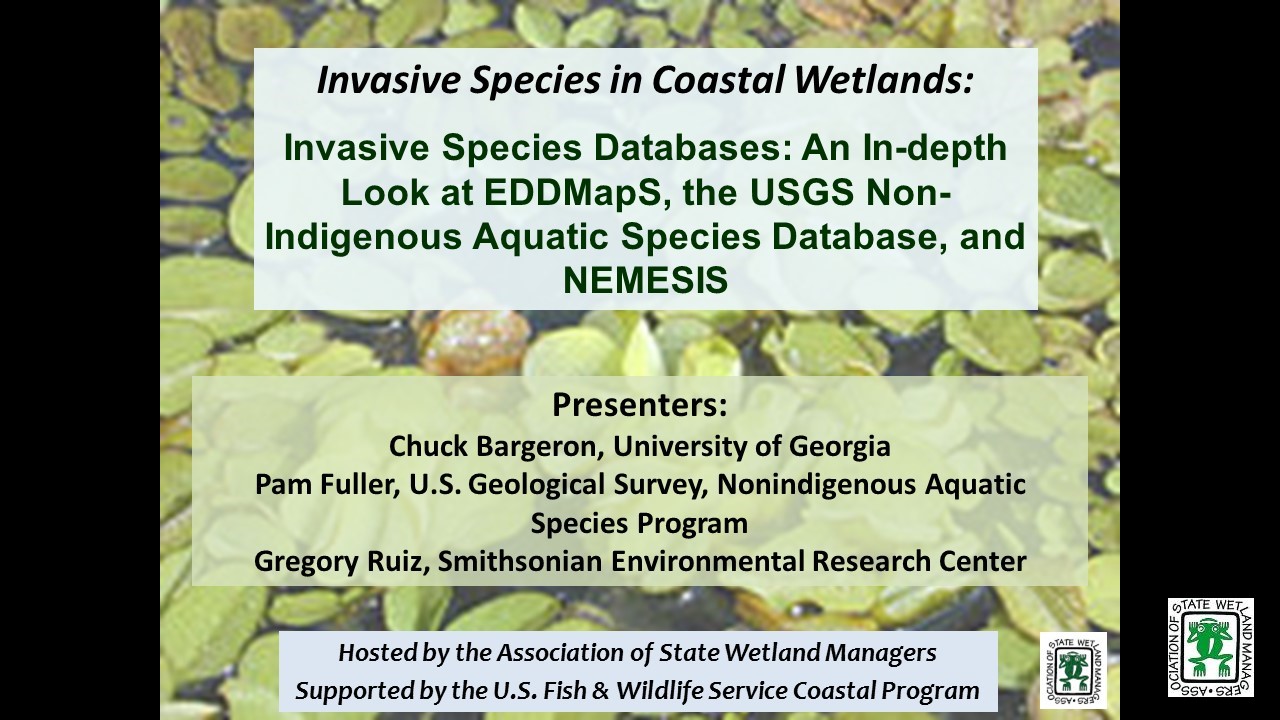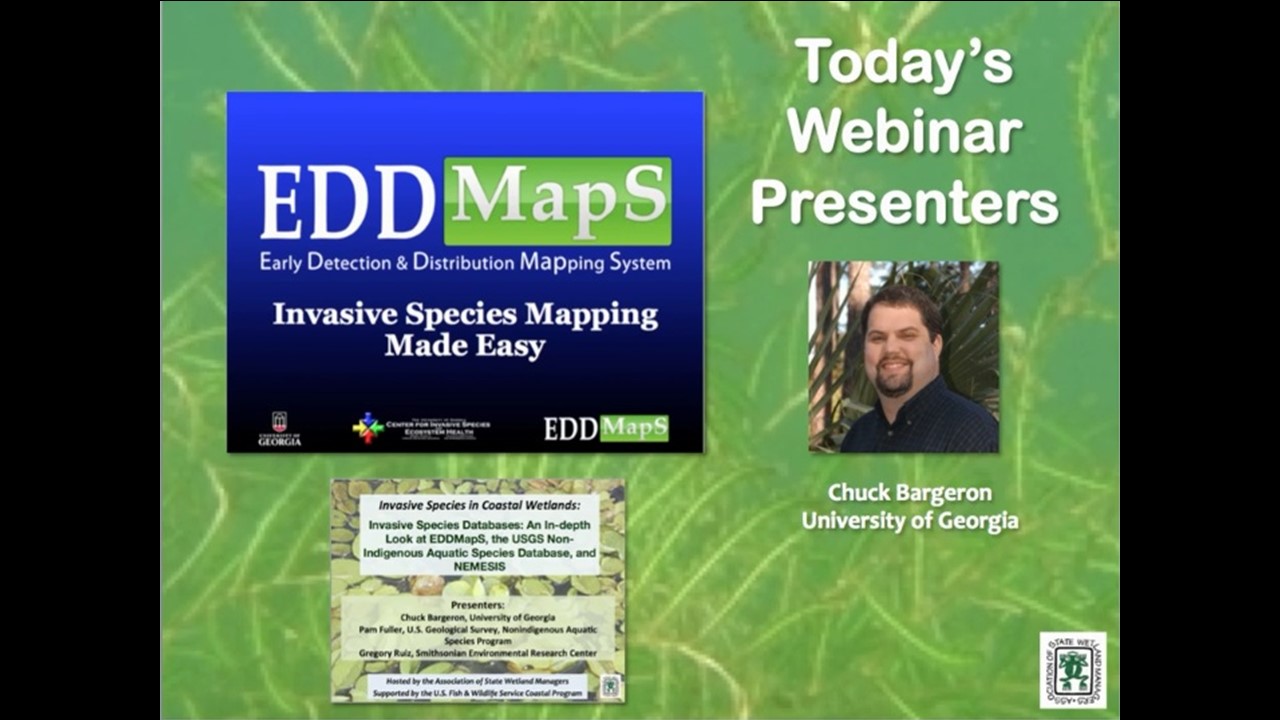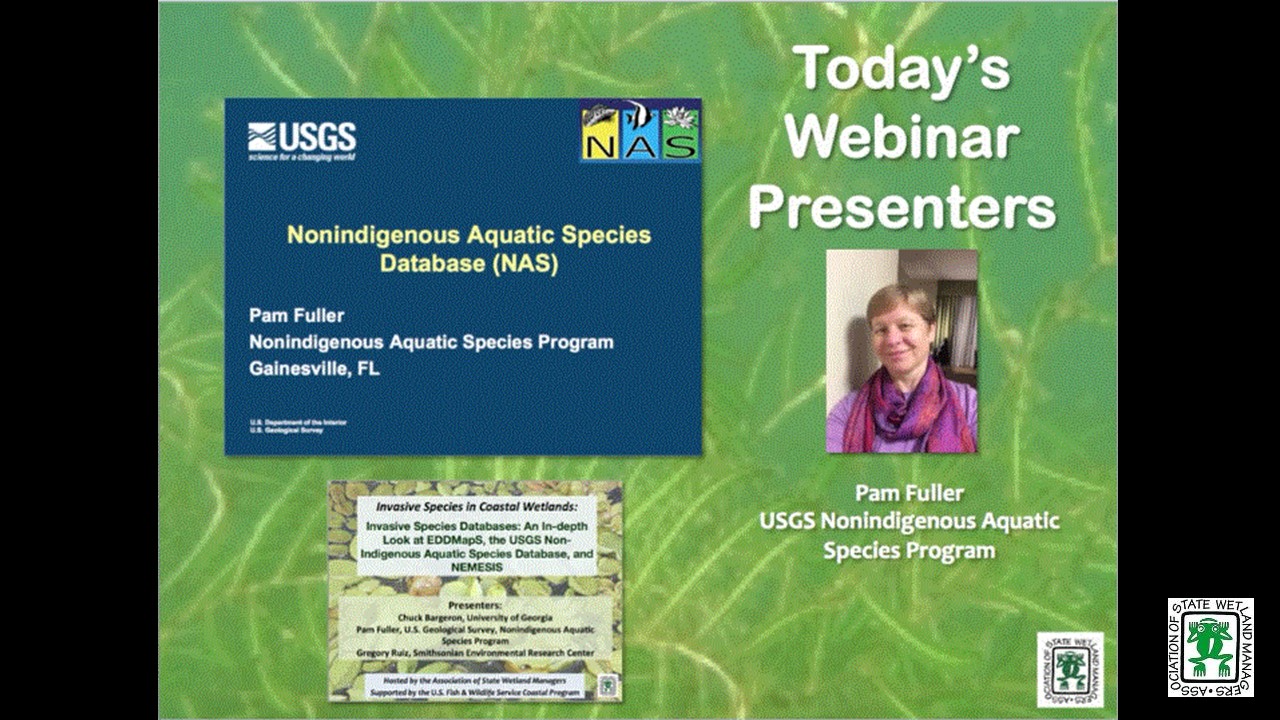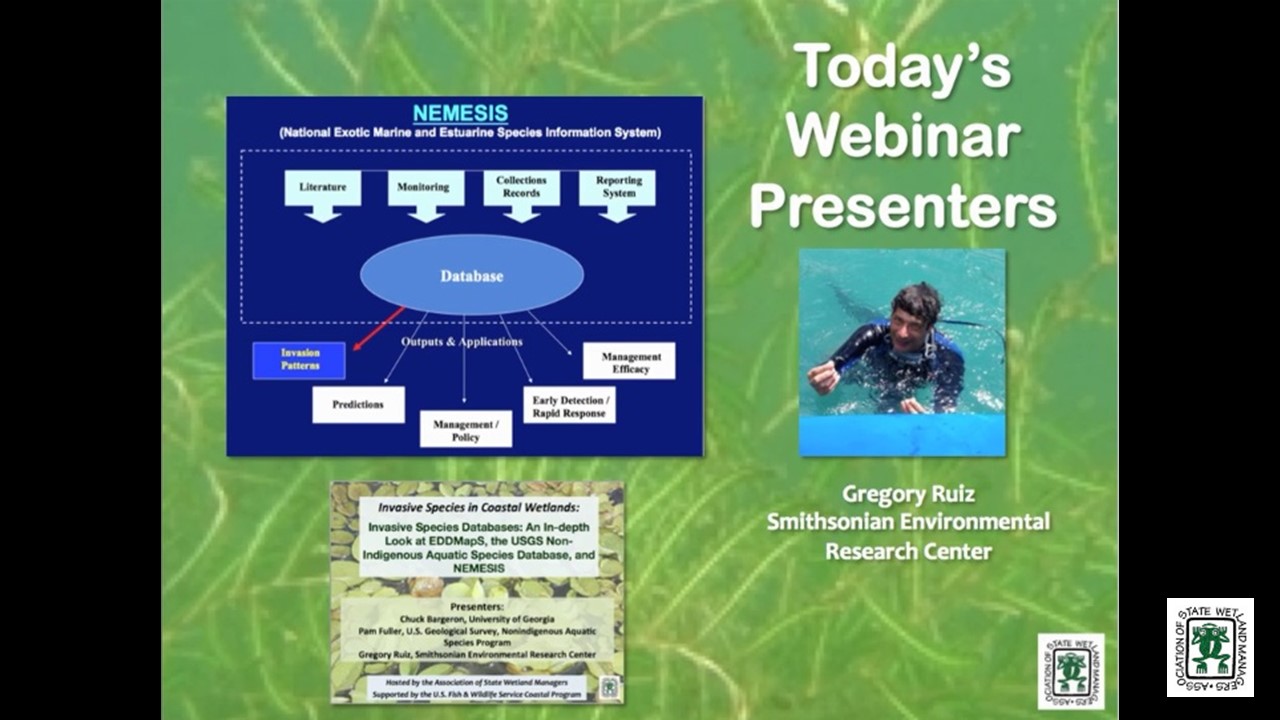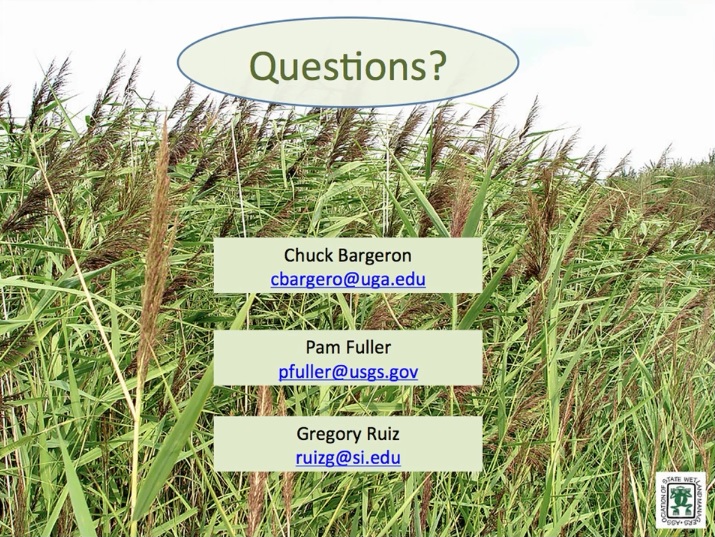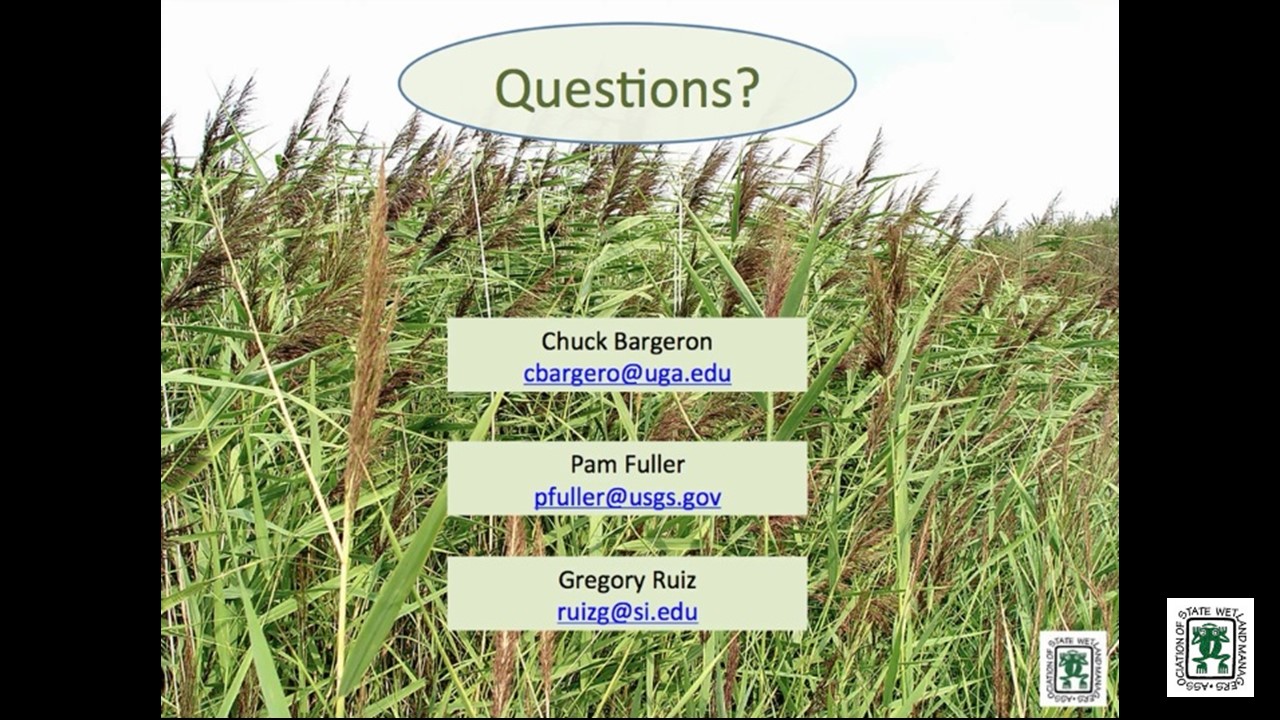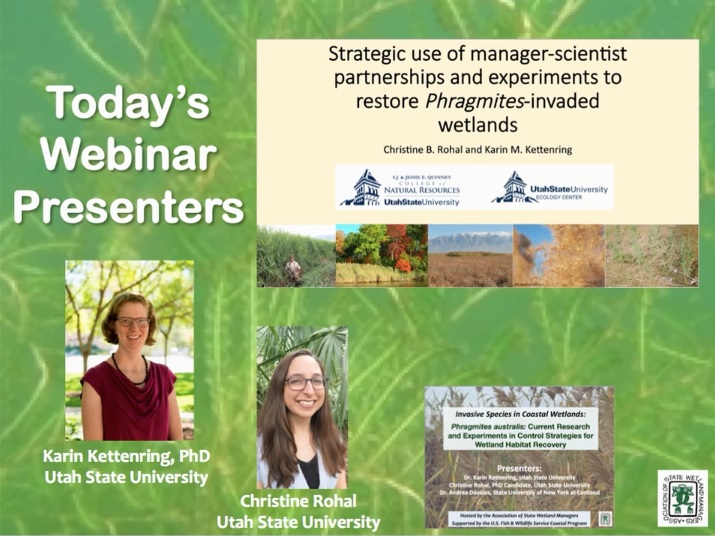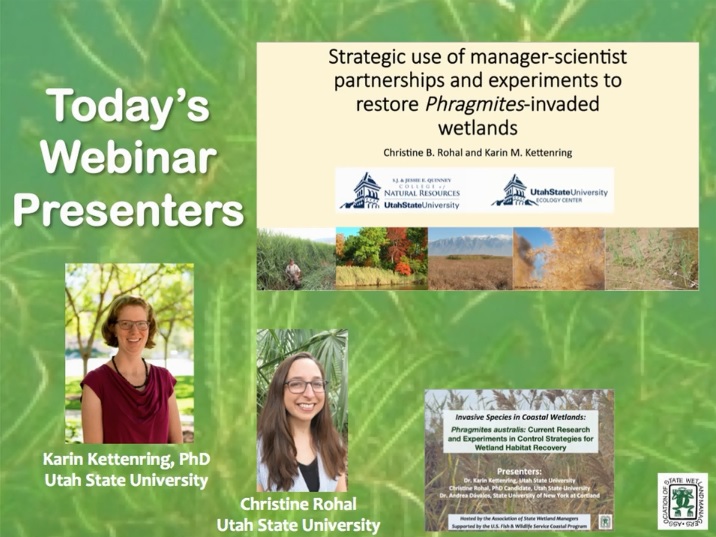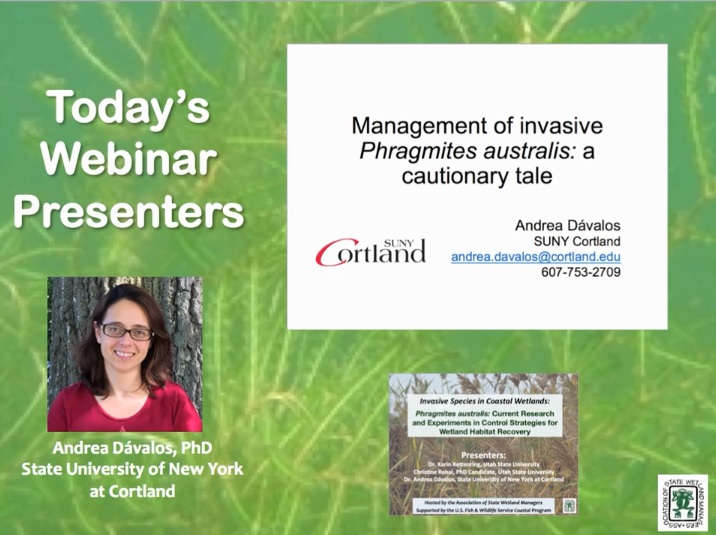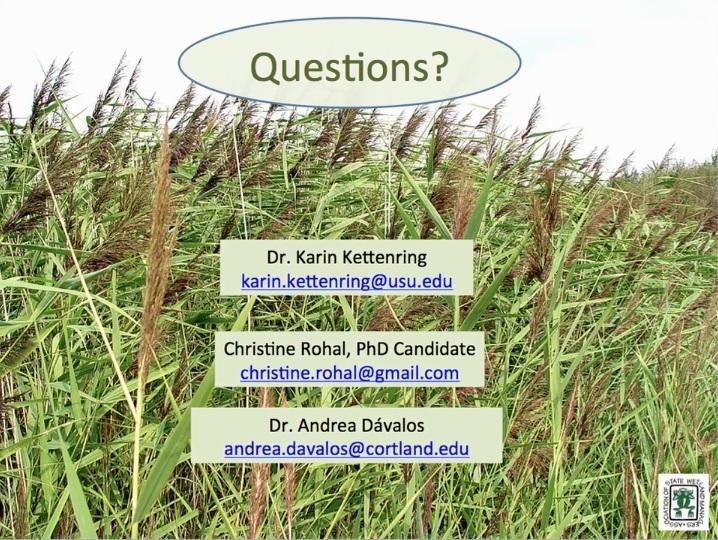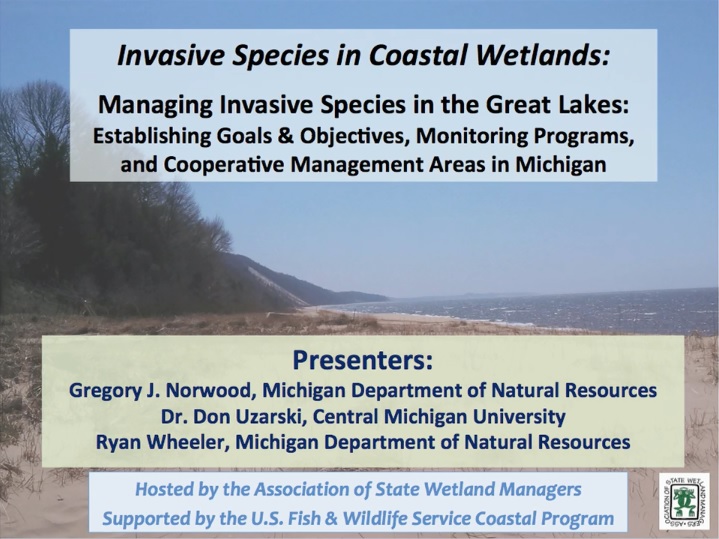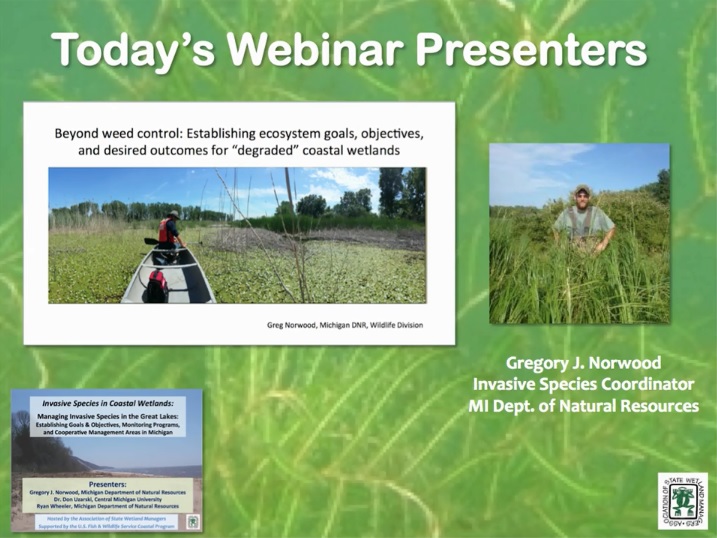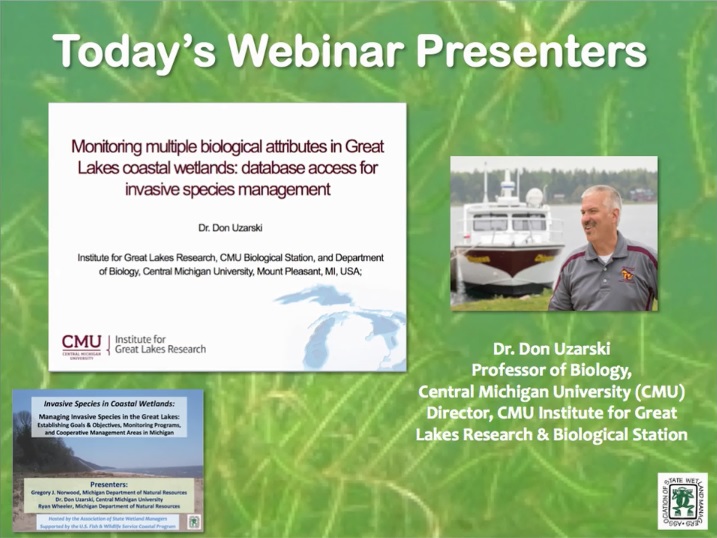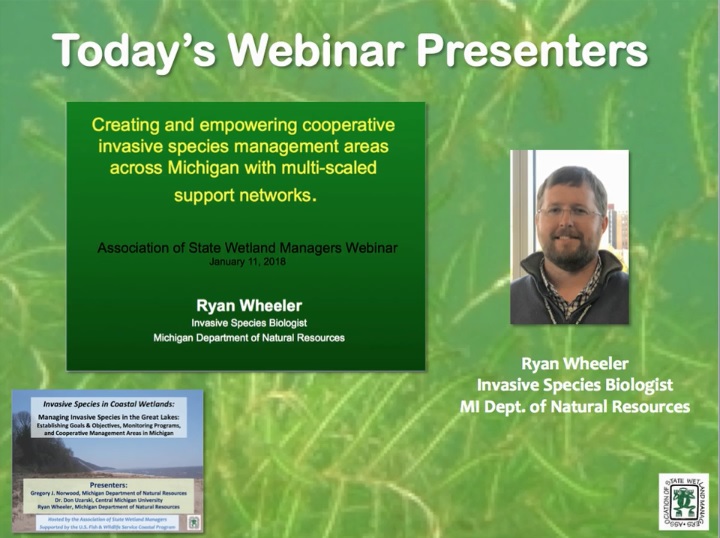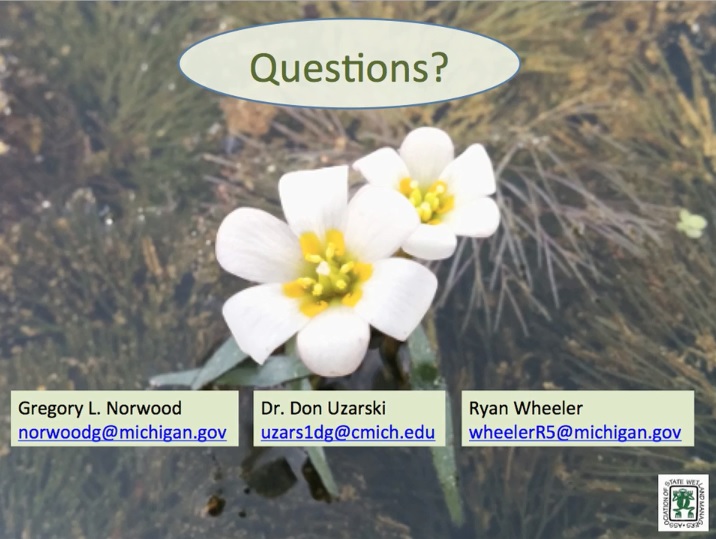Invasive Species Databases: An In-depth Look at EDDMapS, the USGS Non-Indigenous Aquatic Species Database, and NEMESIS
Held Wednesday, March 21, 2018 - 3pm EST
INTRODUCTION
Marla Stelk, Policy Analyst, Association of Stae Wetland Managers [POWERPOINT PRESENTATION]
PRESENTERS
- Chuck Bargeron, University of Georgia [POWERPOINT PRESENTATION]
- Pam Fuller, U.S. Geological Survey, Nonindigenous Aquatic Species Program [POWERPOINT PRESENTATION]
- Gregory Ruiz, Smithsonian Environmental Research Center [POWERPOINT PRESENTATION]
ABSTRACTS
Chuck Bargeron
EDDMapS’ primary goal is to discover the existing range and leading edge of invasive species while documenting vital information about the species and habitat using standardized data collection protocols. EDDMapS allows for data from many organizations and groups to be combined into one database to show a better map of the range of an invasive species. Goals of the current project include: integration of existing regional datasets, increase search options on EDDMapS website, update NAISMA Invasive Species Mapping Standards, and coordinate with local, state and regional organizations to develop early detection networks. After twelve years of development of EDDMapS, it has become clear that these local organizations are key to developing a successful early detection and rapid response network. The University of Georgia Center for Invasive Species and Ecosystem Health has released 15 apps to support data entry into EDDMapS.
Pam Fuller
The Nonindigenous Aquatic Species Database first began in the early 1990s with the passage of legislation related to zebra mussels. Since that time, the group has tracked the distribution of non-native aquatic species nationwide. At present, we focus primarily on freshwater species in the continental US and island territories. The system primarily tracks fish, crustaceans, mollusks, reptiles and amphibians, and obligate aquatic plants. The Program’s interactive website allows users to perform a variety of queries, download data, obtain information from species profiles, and see animations of species’ spread. There is an alert system connected to the database. Registered users receive email alerts when a species of interest is found in a new area. Other components recently added include NAS FaST – the Flood and Storm Tracker which can be used to predict where species may have moved into new drainages based on flooding. The NAS ARM, alert risk mapper, will show the extent of possible initial dispersal based on biology and barriers.
BIOS
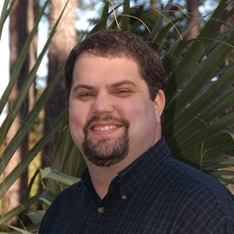 Chuck Bargeron has been with the University of Georgia for 19 years where his work focuses on invasive species and information technology. He has a B.S. and M.S in Computer Science. Websites that he designed have been featured twice in Science Magazine and have received over 1.7 billion hits since 2002. Chuck developed the infrastructure behind Bugwood Images which runs the ForestryImages.org and Invasive.org websites. Recently, Chuck has focused on mapping invasive species and tools for Early Detection and Rapid Response using EDDMapS and smartphone applications. He has led development of 26 smartphone applications including the first apps for the U.S. Forest Service and National Park Service. He was appointed to the National Invasive Species Advisory Council in 2013 and elected as Chair in 2018. Chuck has been an invited speaker at over 80 regional and national conferences and co-authored over 20 journal articles and outreach publications.
Chuck Bargeron has been with the University of Georgia for 19 years where his work focuses on invasive species and information technology. He has a B.S. and M.S in Computer Science. Websites that he designed have been featured twice in Science Magazine and have received over 1.7 billion hits since 2002. Chuck developed the infrastructure behind Bugwood Images which runs the ForestryImages.org and Invasive.org websites. Recently, Chuck has focused on mapping invasive species and tools for Early Detection and Rapid Response using EDDMapS and smartphone applications. He has led development of 26 smartphone applications including the first apps for the U.S. Forest Service and National Park Service. He was appointed to the National Invasive Species Advisory Council in 2013 and elected as Chair in 2018. Chuck has been an invited speaker at over 80 regional and national conferences and co-authored over 20 journal articles and outreach publications.
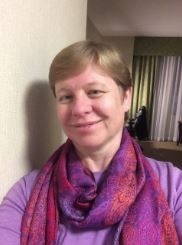 Pam Fuller is the program leader for the USGS Nonindigenous Aquatic Species Program which maintains a nationwide database and a web site of aquatic invaders. She started with the program in its infancy and has developed it to its current state over the past 26 years. Fuller has authored many scientific publications on the topic of aquatic invasive species. She has been involved in numerous national and international invasive species research activities and work groups, particularly in the field of invasive species information management. Ms. Fuller enjoys the work she does because it is so multifaceted. Her work requires knowledge of zoogeography, taxonomy, ecology, databases and web design.
Pam Fuller is the program leader for the USGS Nonindigenous Aquatic Species Program which maintains a nationwide database and a web site of aquatic invaders. She started with the program in its infancy and has developed it to its current state over the past 26 years. Fuller has authored many scientific publications on the topic of aquatic invasive species. She has been involved in numerous national and international invasive species research activities and work groups, particularly in the field of invasive species information management. Ms. Fuller enjoys the work she does because it is so multifaceted. Her work requires knowledge of zoogeography, taxonomy, ecology, databases and web design.
 Gregory Ruiz is a marine ecologist with active research interests in invasion biology, biogeography, and ecology in coastal marine ecosystems. He heads a research group of ~ 40 full-time biologists, based at the Smithsonian Environmental Research Center (SERC) laboratories, located on Chesapeake Bay and San Francisco Bay. Most of his research explores the patterns, mechanisms, and consequences of marine invasions at a multiple spatial and temporal scales. He conducts extensive comparative measurements and experiments among estuaries along the Pacific and Atlantic coasts for North America. A Senior Scientist at SERC for over 25 years, Greg also is a Research Professor and founding co-director of the Aquatic BioInvasion Research and Policy Institute at Portland State University. Greg has published over 140 scientific articles as author or coauthor, focusing primarily on marine invasion ecology and management. He began his career in California and has broad interests in marine biology and dynamics of coastal ecosystems. Greg holds a Ph.D. in zoology from University of California, Berkeley and a B.A. in aquatic biology from the University of California, Santa Barbara. For additional information visit SERC’s Marine Invasion Research Laboratory website at http://invasions.si.edu/.
Gregory Ruiz is a marine ecologist with active research interests in invasion biology, biogeography, and ecology in coastal marine ecosystems. He heads a research group of ~ 40 full-time biologists, based at the Smithsonian Environmental Research Center (SERC) laboratories, located on Chesapeake Bay and San Francisco Bay. Most of his research explores the patterns, mechanisms, and consequences of marine invasions at a multiple spatial and temporal scales. He conducts extensive comparative measurements and experiments among estuaries along the Pacific and Atlantic coasts for North America. A Senior Scientist at SERC for over 25 years, Greg also is a Research Professor and founding co-director of the Aquatic BioInvasion Research and Policy Institute at Portland State University. Greg has published over 140 scientific articles as author or coauthor, focusing primarily on marine invasion ecology and management. He began his career in California and has broad interests in marine biology and dynamics of coastal ecosystems. Greg holds a Ph.D. in zoology from University of California, Berkeley and a B.A. in aquatic biology from the University of California, Santa Barbara. For additional information visit SERC’s Marine Invasion Research Laboratory website at http://invasions.si.edu/.
Phragmites australis: Current Research and Experiments in Control Strategies for Wetland Habitat Recovery
Held Wednesday - February 21, 2018 - 3pm EST
INTRODUCTION
Marla Stelk, Policy Analyst, Association of State Wetland Managers [POWERPOINT PRESENTATION]
PRESENTERS
- Karin Kettenring, Utah State University [POWERPOINT PRESENTATION]
- Christine Rohal, PhD Candidate, Utah State University [POWERPOINT PRESENTATION]
- Andrea Davalos, State University of New York [POWERPOINT PRESENTATION]
ABSTRACTS
Dr. Karin Kettenring and Christine Rohal
Phragmites australis has aggressively invaded wetlands in northern Utah including wetlands along the iconic Great Salt Lake. Since 2010, Utah State University researchers and wetlands managers have partnered to improves Phragmites management techniques and outcomes. In this talk we will discuss (1) how a formal manager survey informed a Phragmites management research experiment, and (2) how these Phragmites management experiments yielded important insights into how best to control Phragmites and the potential for habitat recovery.
Dr. Andrea Dávalos
Land manager organizations spend significant resources controlling invasive plants, yet there is surprisingly little evidence to assess success of invasive plant management. The rapid range expansions of invasive Phragmites australis in North America have prompted large-scale control efforts, although with limited success. Assessment of P. australis management in the Adirondack Park, New York State shows that eradication, through herbicide application, is only achievable for the smallest populations. Long-term control of the invasion will require continuous use of herbicides, not only jeopardizing native wetland biota but also threatening existence of the endemic subspecies P. australis americanus. Alternatively, biological control is a promising and safer tool. Two European stem mining noctuids show very strong, but not absolute, preference for invasive P. australis. Demographic techniques are being implemented to improve host-specificity assessment and evaluate management success. Invasive species management should go beyond short-term suppression of target plants and should incorporate quantitative measurements of outcomes.
BIOS
 Dr. Karin Kettenring is a faculty member in the Department of Watershed Sciences, Quinney College of Natural Resources, Utah State University in Logan, Utah. She has a B.A. in biology from Oberlin College. She received her Ph.D. in applied plant sciences from the University of Minnesota where she worked with Dr. Susan Galatowitsch. Her Ph.D. research focused on restoration of sedges in prairie pothole wetlands. She was also a Postdoctoral Fellow with Dr. Dennis Whigham at the Smithsonian Environmental Research Center where she studied the invasion of Phragmites australis in Chesapeake Bay tidal wetlands. She has been a faculty member at USU since 2008. Her current research efforts focus on (1) the ecology, genetics, and management of wetland invaders, (2) seed ecology of native wetlands plants, with implications for wetland revegetation, and (3) restoration genetics for sustainable, functioning wetland restorations.
Dr. Karin Kettenring is a faculty member in the Department of Watershed Sciences, Quinney College of Natural Resources, Utah State University in Logan, Utah. She has a B.A. in biology from Oberlin College. She received her Ph.D. in applied plant sciences from the University of Minnesota where she worked with Dr. Susan Galatowitsch. Her Ph.D. research focused on restoration of sedges in prairie pothole wetlands. She was also a Postdoctoral Fellow with Dr. Dennis Whigham at the Smithsonian Environmental Research Center where she studied the invasion of Phragmites australis in Chesapeake Bay tidal wetlands. She has been a faculty member at USU since 2008. Her current research efforts focus on (1) the ecology, genetics, and management of wetland invaders, (2) seed ecology of native wetlands plants, with implications for wetland revegetation, and (3) restoration genetics for sustainable, functioning wetland restorations.
 Christine Rohal is a PhD student Karin Kettenring's Wetland Ecology lab at Utah State University in Logan, Utah. Her research focuses on applied questions related to restoring wetland habitats degraded by invasive plant species. Before she moved to Utah for her graduate studies, she worked on habitat restoration projects in Golden Gate National Recreation Area in San Francisco, Grand Canyon National Park, and on the beaches of Jacksonville, Florida.
Christine Rohal is a PhD student Karin Kettenring's Wetland Ecology lab at Utah State University in Logan, Utah. Her research focuses on applied questions related to restoring wetland habitats degraded by invasive plant species. Before she moved to Utah for her graduate studies, she worked on habitat restoration projects in Golden Gate National Recreation Area in San Francisco, Grand Canyon National Park, and on the beaches of Jacksonville, Florida.
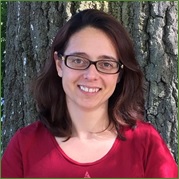 Dr. Andrea Dávalos is an Assistant Professor in the Biological Sciences Department at the State University of New York at Cortland. Her research is motivated by a strong interest in conservation and in the development of tools to restore natural ecosystems. She is particularly interested in addressing issues pertaining to the ecology and management of biological invasions and the factors that drive successful control programs. Her long-term collaborative research combines experimental and modeling approaches to assess impacts of invasive plants and success of management programs.
Dr. Andrea Dávalos is an Assistant Professor in the Biological Sciences Department at the State University of New York at Cortland. Her research is motivated by a strong interest in conservation and in the development of tools to restore natural ecosystems. She is particularly interested in addressing issues pertaining to the ecology and management of biological invasions and the factors that drive successful control programs. Her long-term collaborative research combines experimental and modeling approaches to assess impacts of invasive plants and success of management programs.
Managing Invasive Species in the Great Lakes: Establishing Goals & Objectives, Monitoring Programs, and Cooperative Management Areas in Michigan
Held Thursday, January 11, 2018 - 3:00 p.m. ET
INTRODUCTION
Marla Stelk, Policy Analyst, Association of State Wetland Managers [POWERPOINT PRESENTATION]
PRESENTERS
- Gregory J. Norwood, Michigan Department of Natural Resources [POWERPOINT PRESENTATION]
- Dr. Don Uzarski, Central Michigan University [POWERPOINT PRESENTATION]
- Ryan Wheeler, Michigan Department of Natural Resources [POWERPOINT PRESENTATION]
ABSTRACTS
Gregory J. Norwood
Beyond weed control: Establishing ecosystem goals, objectives, and desired outcomes for degraded coastal wetlands
Invasive plant removal is usually an integral part of coastal wetland restoration projects, sometimes at a relatively high cost. While there is acceptance of the biodiversity loss associated with invasive plants such as reed (Phragmites australis) and narrow-leaved cattail (Typha angustifolia and T. x glauca), managers are ultimately responsible for considering trade-offs of various intervention strategies. This talk describes the importance of establishing ecosystem goals and objectives to achieve specific conservation outcomes before invasive species control efforts begin so that decisions about trade-offs become easier. Examples from western Lake Erie will reveal a wide range of desired outcomes because of various local constraints such as the nature of the surrounding landscape. Desired conservation outcomes are more likely to be achieved if there is clear linkage between invasive species removal and the stated project goals and objectives. Removal of invasive species always involves difficult trade-offs; however, practitioners frequently monitor acres treated instead of the overall impacts of control projects in achieving their conservation goals.
Dr. Don Uzarski
Monitoring multiple biological attributes in the Great Lakes coastal wetlands: database access for invasive species management
Since European settlement, over 50% of Laurentian Great Lakes coastal wetlands have been lost, causing growing concern by government agencies. To facilitate information sharing between public, private, and government agencies throughout the basin, we developed standardized methods and indicators used for assessing wetland condition. Using an ecosystem approach, birds, anurans, fish, macroinvertebrates, vegetation, and physicochemical conditions were sampled in coastal wetlands of all five Great Lakes, US and Canada. Our primary objective was to implement a standardized basin-wide monitoring program that would be a powerful tool to inform coastal wetland conservation and restoration priorities throughout the basin.
Ryan Wheeler
Creating and empowering cooperative invasive species management areas across Michigan with multi-scaled support networks.
The challenges associated with Invasive Species Management span geo-political boundaries, property ownership boundaries, and even human values. In order to overcome these challenges, it can be beneficial to view individual invasive species problems as part of a much bigger picture. Regional Cooperative Invasive Species efforts are a practical implementation of this “big picture” mindset. This presentation will cover recent efforts to create and empower Cooperative Invasive Species Management Areas across all of Michigan. It will also cover several networks that continue to provide critical support and value to these groups at local, state, and basin-wide scales.
BIOS
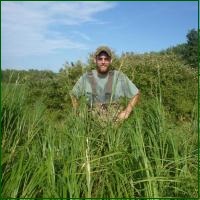 Greg J. Norwood serves as Invasive Species Coordinator for the Michigan Department of Natural Resources – Wildlife Division. Previously, he was a wildlife biologist for the U.S. Fish and Wildlife Service at Detroit River International Wildlife Refuge where he was involved in forming the Detroit River-Western Lake Erie Cooperative Weed Management Area which includes some of the “weediest” natural areas in the state. Most of his work involved a variety of natural area projects, including adding land to the Refuge, prescribed fire, ecological inventories, wetland impoundment management, transitioning agricultural fields to other habitat, facilitating public use, and prescribed fire. Currently, he assists the Division and partners with decisions and strategy surrounding invasive species.
Greg J. Norwood serves as Invasive Species Coordinator for the Michigan Department of Natural Resources – Wildlife Division. Previously, he was a wildlife biologist for the U.S. Fish and Wildlife Service at Detroit River International Wildlife Refuge where he was involved in forming the Detroit River-Western Lake Erie Cooperative Weed Management Area which includes some of the “weediest” natural areas in the state. Most of his work involved a variety of natural area projects, including adding land to the Refuge, prescribed fire, ecological inventories, wetland impoundment management, transitioning agricultural fields to other habitat, facilitating public use, and prescribed fire. Currently, he assists the Division and partners with decisions and strategy surrounding invasive species.
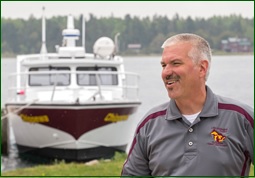 Dr. Don Uzarski, CMU Professor of Biology, serves as the Director of CMU’s Institute for Great Lakes Research and Biological Station on Beaver Island, MI. He is a limnologist and aquatic ecologist with a focus on measures of ecosystem health of Great Lakes coastal wetlands.
Dr. Don Uzarski, CMU Professor of Biology, serves as the Director of CMU’s Institute for Great Lakes Research and Biological Station on Beaver Island, MI. He is a limnologist and aquatic ecologist with a focus on measures of ecosystem health of Great Lakes coastal wetlands.
Uzarski leads a 10-year $20 million Great Lakes coastal wetland-monitoring program for the US EPA. He can speak to a wide range of topics including human impacts on waterways, indicators of ecosystem health, pollution and runoff and the overall health of the Great Lakes. He has published over 60 peer-reviewed manuscripts, most of which have been wetlands related. His work has been cited in scientific journals over 1200 times.
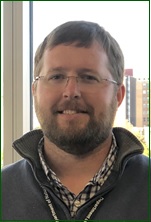 Ryan Wheeler is the Invasive Species Biologist for Michigan’s Department of Natural Resources, Forest Resources and Wildlife Divisions. Ryan works on many aspects of comprehensive invasive species management, with an emphasis on building and strengthening collaborative partnerships. Some of Ryan’s key responsibilities include serving as technical contact for projects funded by Michigan’s invasive species grant program and leading a multi-agency committee working on decontamination policy and recommendations for preventing the spread of invasive species in Michigan. Ryan also serves on the boards of the Michigan Wetland Association and the Midwest Invasive Plant Network.
Ryan Wheeler is the Invasive Species Biologist for Michigan’s Department of Natural Resources, Forest Resources and Wildlife Divisions. Ryan works on many aspects of comprehensive invasive species management, with an emphasis on building and strengthening collaborative partnerships. Some of Ryan’s key responsibilities include serving as technical contact for projects funded by Michigan’s invasive species grant program and leading a multi-agency committee working on decontamination policy and recommendations for preventing the spread of invasive species in Michigan. Ryan also serves on the boards of the Michigan Wetland Association and the Midwest Invasive Plant Network.
![]()
View Past Invasive Species Webinars Here
| 2017 |

